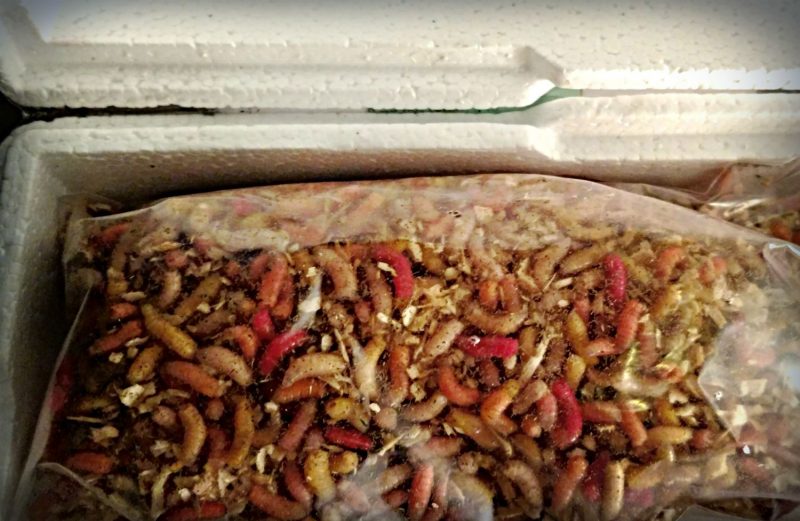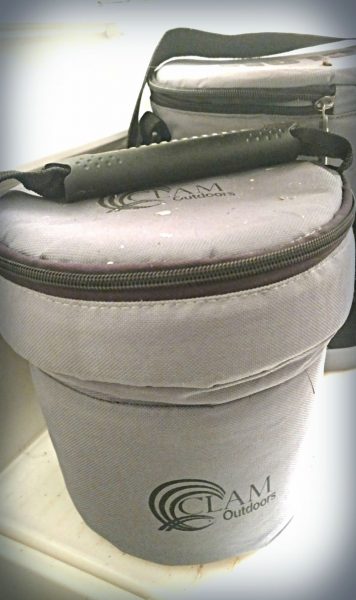How to Keep Live Bait Kicking Throughout the Winter
Matt Breuer 02.23.18

Millions of ice anglers across the ice belt head to their local bait shops once lakes become covered with ice and snow. They’re in search of live bait — and the fresher and livelier the better.
Well, what if you don’t have a bait shop nearby, or don’t want to have to stop at the bait shop daily? What if I said that you can essentially make a dozen or less trips to the bait shop per season, or if you’re really stubborn, you won’t even have to leave the house to acquire bait, and keep it alive?

Maggots
Maggots, spikes, Euros . . . these are all common names for Eurolarvae, which is a term that can be taken as it sounds: European larvae. These maggots were originally commercially grown and distributed by dealers in the U.K., and have become extremely popular with ice anglers across the U.S. and Canada. Many anglers are even utilizing them throughout the summer months as well. Eurolarvae are larvae from European blow flies. Keep this in mind as you read on . . .

Purchasing maggots can be as simple as opening your smartphone or laptop. Many large-scale bait dealers have websites and will ship maggots to your door in a convenient Styrofoam container. Websites such as www.vadosbait.com and www.ja-dabait.com are two reliable dealers. Or, if you stop at your local bait shop, they can usually order large quantities upon request. You can get an assortment of colors from plain white to red, blue and orange. (Fun fact: Maggots are white naturally, and bait produces feed the maggots meat with red, blue or orange food dye to change the maggots’ colors.)
Once you’ve got your maggots, you need to know how to keep them alive.
I hit the ice with Dave Genz (aka Mr. Ice Fishing) the other day, and we discussed bait and methods for keeping things alive. I mentioned that I had just gotten an order of 2,000 maggots, and he said that he had just received 10,000. (Can you guess who fishes more?!)

We both have similar methods for keeping maggots alive, with our own twists. The average refrigerator temperature rides between 35 and 40 degrees. Maggots are best kept at 32-33 degrees. The coldest spot in your regular fridge will keep maggots semi-dormant, and ready for use throughout the winter. I store mine in a plastic bag, in a loose foam container. Genz uses large plastic containers. We both have designated bait fridges, so we’re able to keep the temp down without having to worry about food freezing, pop cans exploding, etc. If you don’t have a bait fridge, remember to keep maggots in the coldest spot in your home fridge.

When you’re ready to hit the ice, drop what you’re going to use for the day into a Clam Bait Puck (above), and put it in a pocket close to your body. Once your body heat hits them, they’ll come to life and start wiggling like crazy, as if you had just picked them up at the bait shop.
As for correctly rigging maggots on a hook: Maggots have two black dots on their “head” end. Slightly pinch the maggot, and you’ll see a scent sac bulge out near the two black dots. The hook goes through that bulge. Too large of a hook will rip the maggot, so size 8 or smaller is ideal. Be sure you puncture the scent sac with your hook. Taking the time to hook your maggots correctly can determine whether you’re going to catch a fish or not, or whether you’ll be able to keep an active school of fish biting, or if they’ll move on. Check out my simple sketch below for the exact location on where to hook a maggot.

When you’re done fishing, simply return the maggots to the large container. Just be sure they are dry, and don’t put dead ones into the container.
Check your bulk maggots weekly, sifting them through a strainer and picking out dead ones. Once a few maggots die, more will follow. Removing the dead ones with haste will ensure a clean and healthy clan. Mr. Genz likes to use a system that allows the wiggling ones to make their way through holes, allowing him to pick out dead ones and keep the bedding clean.
Finally, don’t forget your bait puck in your jacket or truck because you’re sure to find large blow flies in the puck after a warm spell hits.
Wax Worms
Wax worms or “waxies” are similar to Eurolarvae. Commonly called “bee moths” in the South, wax worms are the caterpillars of wax moths. They feed on several things in the wild, most often beeswax, which is where the name “bee moth” comes from.
Waxies are very close to maggots in what they need to stay alive longer. They need to be kept cool, in a semi-dormant state, and dead ones need to be cleaned out of the clan regularly.
When transferred to a bait puck and put near a warm body, they too will come to life. They also need to be hooked properly — head first, breaking their scent sac.
Minnows
Minnows can be very fickle during summer. Everyone has dealt with the loss of a bag of shiners or sucker minnows before even hitting the water. It’s a tough pill — and bill — to swallow. Bait isn’t getting cheaper by any means. The cooler temps during winter help prevent this, but there’s a happy medium, because frozen blocks of ice with frozen minnows in them aren’t exactly good either.

Again, it’s about temperature, and a bait fridge gives an angler a distinct advantage right off the bat. I keep my minnows in a Clam Bait Bucket with Insulated Carry Case (above). I run small, medium and large combinations. They live in my bait fridge, right next to the maggots. The insulated carry case keeps the minnows from getting too cold, and if the water is kept clean, the minnows will move enough to create their own oxygen and keep the water from freezing. Essentially, the more active the minnows, the more oxygen is diffused from the air.
Check out the video below that explains these innovative bait buckets in more detail.
When talking about keeping the water clean, there must be a discussion about tap water. Fact: Tap water contains metals and chemicals that aren’t good for minnows. I use distilled water, or melted snow. When the water is kept clean, minnows will stay alive for weeks in a bait fridge.
If you don’t have a bait fridge, don’t fret. Several companies offer aerators that are battery operated, and will last for a long time before you must swap out batteries. Invest a few extra bucks and you can get yourself an aerator that plugs into a wall outlet. Minnows can be kept at much cooler temps with an aerator, as the water is always moving. Oxygenation is higher as well, keeping the minnows lively and ready for action. If you have an abundance of minnows, or have larger suckers for northern pike, a 5-gallon pail will work tucked away in your garage. Don’t place more than a dozen large suckers (6-10 inchers) in a single bucket, and be sure to keep an aerator running 100 percent of the time. You can’t over-aerate minnows.

Important tip: Do NOT leave your minnows in a bag with oxygen for 24 hours, thinking they will be fresh and lively the next day. Cold air sucks the life out of a bag of minnows quickly, and there’s always the risk of a small hole or leak with commercial bags. Transfer the minnows to a larger bucket and save yourself the heartache of fishing with dead, stinky minnows.
Fish On!
Whether you’re using maggots, waxies or minnows, keep two things in mind, and you’ll be able to fish longer and keep bait longer: Control the temperature, and keep things clean.
Hopefully with these tips and reminders, you’re biggest problem will be running out of bait because the fish are biting, and not tossing bait out because it’s dead.
Editor’s note: If you’re in northern Minnesota this winter and want to spend the day on the water with Matt Breuer (below), check out his website Northcountry Guide Service.


